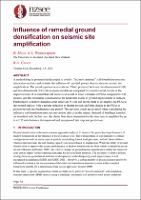Influence of remedial ground densification on seismic site amplification

Download
Date
2023-04-19Authors
Meite, Romain
Wotherspoon, Liam
Green, Russell
Metadata
Show full item recordAbstract
While the capability of remedial ground densification techniques to mitigate the adverse effects of liquefaction has been widely investigated in recent decades, the characterization of ground motion amplification in the improved zone and its surroundings has received little attention. In this study, parametric total stress ground response analyses are conducted to evaluate the change in pseudo-spectral accelerations (PSA) developed at the ground surface for various extents of ground densification, comparing the predictions between one-dimensional (1-D) and two-dimensional (2-D) models. It is found that 1-D models tend to provide lower estimates of PSAs around the fundamental site period compared to 2-D models, and this is dependent on the horizontal extent of the ground improvement. For both models, the frequency content of ground motions is significantly affected when the near surface soil is densified and stiffened, resulting in a shift of the largest amplification towards shorter periods. A densified crust overlying soft soil layers tends to de-amplify the PSAs at the ground surface, with a greater reduction at shorter periods and little change in the PSAs at periods beyond the fundamental site period. The previous trends are reversed when considering the influence soil-foundation-structure interaction effects on the seismic demand of buildings founded on densified soils. In this case, the elastic base shear transmitted to the structures is amplified by up to 20% between the improved and unimproved ground responses.
